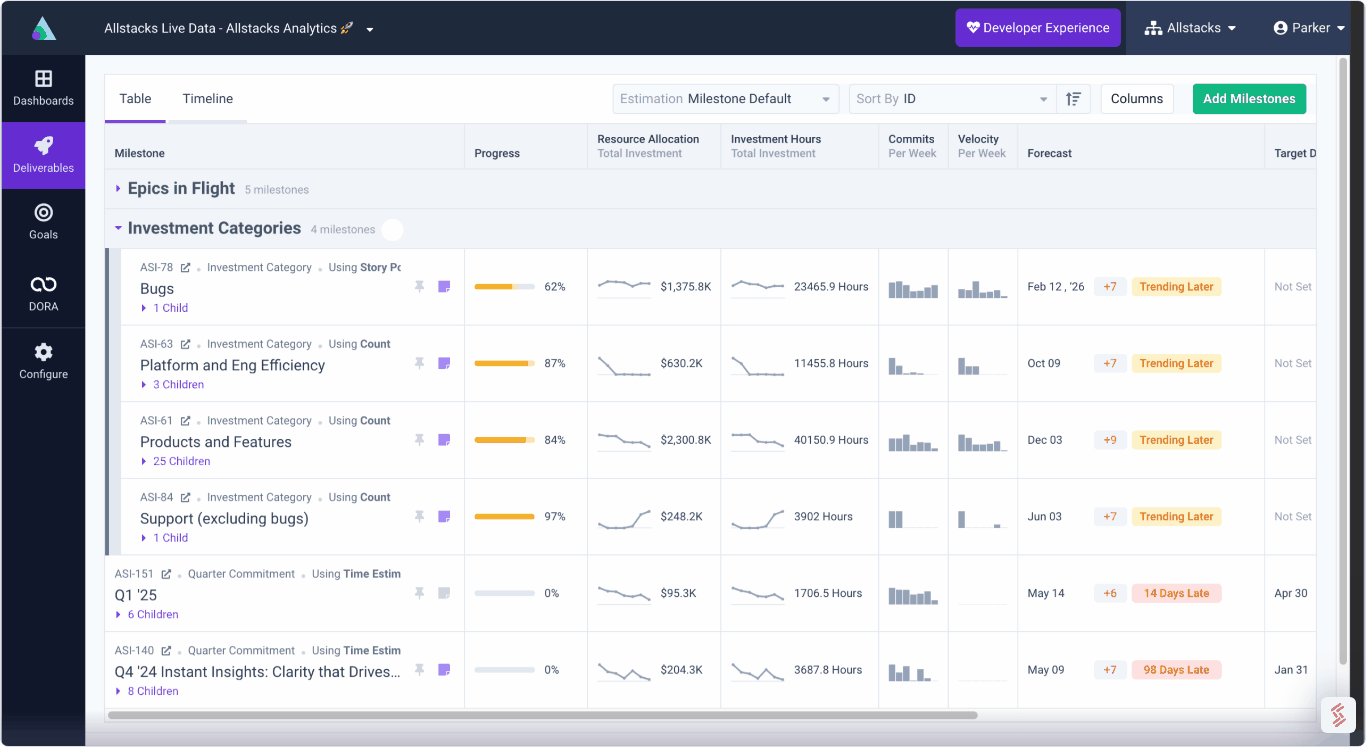.png)
Software Engineering Intelligence
-
Intelligence Engine
On-demand exhaustive AI-analysis
-
Engineering Investment
Complete visibility into time & dollars spent
-
360º Insights
Create meaningful reports and dashboards
-
Project Forecasting
Track and forecast all deliverables
DevEx
-
Developer Surveys
Create and share developer surveys
Software Capitalization
-
R&D Capitalization Reporting
Align and track development costs
What Product Managers Wish Engineering Managers Knew About Planning
At Allstacks, we interact with product managers and engineering leaders every day across hundreds of software teams. We see firsthand how these organizations can sometimes seem disconnected—working with different business terminology, operating on different timelines, and pursuing what appear to be disparate goals.
Getting it Rolling - Building a Great Product & Engineering Partnership
You know those quarterly planning sessions where your team and the product org seem to be operating from completely different playbooks? Your engineers are focused on technical debt and system architecture, while product managers are talking about user metrics and market needs. Everyone wants to build great software, but the planning conversations feel like you're managing two different functions that happen to work on the same codebase.
As someone who's spent time in both product and engineering leadership roles, here's what I wish more engineering managers understood about how product teams approach planning—and why it matters for your team's success.
Help Your Team Connect Features to Business Impact
Your engineers naturally think in terms of technical deliverables—systems shipped, performance improved, bugs eliminated. But when product managers plan roadmaps, they're obsessing over whether users will actually benefit and how that translates to business results.
This isn't just philosophical—it changes how your team should approach trade-offs during development. The goal is pursuing features that actually work for users over building architecturally perfect systems. Sometimes the quick solution that gets users what they need is better than the elegant solution that takes three times longer to build.
As an engineering manager, you can bridge this gap. Help your team understand the "why" behind features during planning sessions. When priorities inevitably shift mid-quarter, your engineers can adapt their technical approach while preserving the intended business impact.
Build Planning Processes That Embrace Right-Sized Specifications
Here's what I see happening in too many engineering organizations: when faced with unclear requirements, dev teams default to asking for exhaustively detailed specifications upfront, while product managers either provide half-baked requirements or try to perfect every detail before handoff. Neither approach works well.
The most effective teams I've managed find the middle ground—creating "right-sized" specifications that give engineers enough clarity to start building while leaving room for continuous improvement. This means product managers and engineers collaborate to define the core user problem, key success metrics, and major technical constraints upfront, but they intentionally leave implementation details flexible.
Instead of trying to anticipate every edge case before development starts, encourage your team to build in regular collaboration touchpoints. Plan features with explicit checkpoints where product and engineering can evaluate what's working, what isn't, and how the solution should evolve. This approach lets engineers start building sooner while creating space for both teams to learn and adapt as the feature takes shape.
Create Communication Norms That Balance Speed and Quality
The key is finding the right balance between moving fast and maintaining quality standards - which creates predictability. When your team optimizes for the fastest practical pace while delivering consistently high quality, both teams can make reliable commitments to stakeholders.
Set clear expectations about early communication: "If something feels like it's taking longer than expected, let me know immediately with your best assessment—even if you can't quantify it perfectly yet." This gives product managers the intelligence they need while maintaining quality standards. The result is predictable delivery at the fastest sustainable pace.
Help Your Team Understand Business Context and Constraints
Business requirements aren't arbitrary constraints—they're problem-solving inputs. When your engineers understand why deadlines matter (a major customer demo that could close a key enterprise deal) or why performance optimization is critical (it directly impacts user retention and reduces churn), they can suggest better technical approaches and make smarter trade-offs.
Share the strategic reasoning behind priorities, not just the requirements. Engineers who understand business context become problem-solving partners who help find technical solutions that work within real-world constraints.
Foster Ongoing Planning Collaboration, Not Just Quarterly Handoffs
Don't treat quarterly roadmaps as set-and-forget documents. As the saying goes, "The plan is the plan until the plan changes"—and business needs can evolve rapidly.
Effective planning requires continuous collaboration throughout the quarter. Your engineers' technical discoveries should immediately inform product decisions, not wait for the next planning cycle. Build regular touchpoints where both teams ask: "What did we learn? How can we adapt?"
The strongest partnerships treat planning as an ongoing feedback loop, maintaining the flexibility to respond to changing business needs while keeping long-term goals in sight.
Closing it out
The most successful product-engineering partnerships we see at Allstacks share a common thread: they've moved beyond viewing planning as a handoff between functions to treating it as a shared discipline. When engineering managers help their teams understand business context, embrace iterative planning, and maintain ongoing collaboration with product teams, the result is faster delivery of higher-quality features that actually solve user problems. The planning conversation becomes inclusive of both "what are we building?" and “how can we improve together? "—and that makes all the difference.



.png)